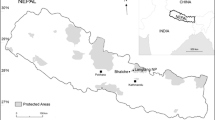Abstract
This study assessed the net above-ground carbon stock in six community forests in the Dolakha district, Nepal. A survey was conducted of above-ground timber species, using random sampling. A tree-ring chronology for Pinus roxburghii was created to construct a growth model representative of the various mainly-pine species. The allometric model combined with tree ring analysis was used to estimate carbon stock and annual growth in the above-ground tree biomass. The out-take of forest biomass for construction material and fuelwood was estimated on the basis of interviews and official records of community forest user groups. The average annual carbon increment of the community forests was 2.19 ton/ha, and the average annual carbon out-take of timber and fuelwood was 0.25 ton/ha. The net average carbon balance of 1.94 ton/ha was equivalent to 117.44 tons of carbon per community forest annually. All the community forests were actively managed leading to a sustainable forest institution, which acts as a carbon sink. It is concluded that community forests have the potential to reduce emissions by avoiding deforestation and forest degradation, enhance forest carbon sink and improve livelihoods for local communities.
Similar content being viewed by others
Notes
1 US$ = 83.44 NRP as of October 15, 2012.
References
Acharya KP (2002) Twenty-four years of community forestry in Nepal. Int For Rev 4(2):149–156
Acharya AK, Kafle N (2009) Land degradation issues in Nepal and its management through agroforestry. J Agric Environ 10(1):115–123
Adhikari MD (2011) Evaluating annual carbon balance of aboveground woody biomass in community forest of mid hills, Nepal: a case study of Bhaiyadevi Community Forest in Salyan District. University of Greifswald, Germany, Master Thesis
Banskota K, Karky BS, Skutsch M (2007) Reducing carbon emission through community managed forests in the Himalaya. ICIMOD, Kathmandu, Nepal
Baral SK, Malla R, Ranabhat S (2009) Above-ground carbon stock assessment in different forest types of Nepal. Banko Janakari 19(2):10–14
Brown S (2002) Measuring carbon in forests: current status and future challenges. Environ Pollut 116(3):363–372
DDC (1999) District situational analysis of the Dolakha:district profile. District Development Committee, Dolakha, Nepal
DDC (2011) District profile 2068. District Development Committee, Dolakha, Nepal
Dixon RK, Brown S, Houghton RA, Solomon AM, Trexler MC, Wisniewski J (1994) Carbon pools and flux of global forest ecosystems. Science 263(5144):185–190
Gautam AP (2009) Equity and livelihoods in Nepal’s community forestry. Int J Soc For 2(2):101–122
Gautam AP, Shivakoti GP, Webb EL (2004) Forest cover change, physiography, local economy, and institutions in a mountain watershed in Nepal. Environ Manag 33(1):48–61
Gibbs HK, Brown S, Niles JO, Foley JA (2007) Monitoring and estimating tropical forest carbon stocks: making REDD a reality. Environ Res Lett 2(4):1–13
Giri K, Ojha H (2010) Enhancing livelihoods from community forestry in Nepal: can technobureaucratic behaviour allow innocation systems to work? 9th European IFSA Symposium, 4–7 July. Austria, Vienna
IPCC (2001) Climate Change 2001; Impact, Adaptation, and Vulnerability. Cambridge University Press, Cambridge
Joshi L, Sharma N, Ojha P, Khatri DB, Pradhan R, Karky B, Pradhan U, Karki S (2010) Moving beyond REDD: reducing emissions from all land uses in Nepal. Final national report, ASB Partnership for the Tropical Forest Margins Nairobi
Karky BS, Skutsch M (2010) The cost of carbon abatement through community forest management in Nepal Himalaya. Ecol Econ 69(3):666–672
Klooster D, Masera O (2000) Community forest management in Mexico: carbon mitigation and biodiversity conservation through rural development. Global Environ Change 10(4):259–272
Lal R (1999) World soils and greenhouse effect. Global Change News Letter 37(1):4–5
Lal R (2005) Forest soils and carbon sequestration. For Ecol Manag 220(1–3):242–258
Levy PE, Cannell MGR, Friend AD (2004) Modelling the impact of future changes in climate, CO2 concentration and land use on natural ecosystems and the terrestrial carbon sink. Global Environ Change 14(1):21–30
MacDicken KG (1997) A guide to monitoring carbon storage in foretry and agroforestry projects. Forest Carbon Monitoring Program, Winrock International Institute for Agriculture Development
Mandal RA, Laake PV (2007) Carbon sequestration in community forests: an eligible issue for CDM (A case study of Nainital, India). Banko Janakari 15(2):53–61
Masera OR, Garza-Caligaris JF, Kanninen M, Karjalainen T, Liski J, Nabuurs GJ, Pussinen A, de Jong BHJ, Mohren GMJ (2003) Modeling carbon sequestration in afforestation, agroforestry and forest management projects: the CO2FIX V. 2 approach. Ecol Model 164(2–3):177–199
MOF (2012) Economic survey: fiscal year 2011/12. Ministry of Finance, Government of Nepal, Kathmandu
Prentice IC (2001) The carbon cycle and atmospheric carbon bioxide. In: Climate Change 2001: The Scientific Basis IPCC, Cambridge University Press, Cambridge
Sharma ER, Pukkala T (1990) Volume equations and biomass prediction of forest trees of Nepal. Ministry of Forests and Soil Conservation, Forest Survey and Statistics Division, Kathmandu, Nepal
Shrestha S (2011) Assessing the balance of timber carbon and benefit sharing in community forests of Dolakha, Nepal. MSc thesis, Tribhuvan University, Institute of Forestry, Pokhara, Nepal
Staddon S (2009) Carbon financing and community forestry: a review of the questions, challenges and the case of Nepal. J For Livelihood 8(1):25–32
Stinson G, Freedman B (2001) Potential for carbon sequestration in Canadian forests and agroecosystems. Mitig Adapt Strate Global Change 6(1):1–23
Upadhyay TP, Sankhayan PL, Solberg B (2005) A review of carbon sequestration dynamics in the Himalayan region as a function of land-use change and forest/soil degradation with special reference to Nepal. Agric Ecosys Environ 105(3):449–465
WECS (2010) Energy sector synopsis report 2010. Water and Energy Commission Secretariat, Kathmandu, Nepal
Acknowledgments
The data used in this paper is part of the thesis of one of the authors, submitted to Tribhuvan University, Kathmandu, Nepal for the partial fulfillment of the requirement of MSc Degree. The authors would like to acknowledge the Norad Master program for providing financial assistance for conducting the research. The authors are grateful to Steve Harrison for his valuable editorial support on this manuscript.
Author information
Authors and Affiliations
Corresponding authors
Rights and permissions
About this article
Cite this article
Shrestha, S., Karky, B.S., Gurung, A. et al. Assessment of Carbon Balance in Community Forests in Dolakha, Nepal. Small-scale Forestry 12, 507–517 (2013). https://doi.org/10.1007/s11842-012-9226-y
Accepted:
Published:
Issue Date:
DOI: https://doi.org/10.1007/s11842-012-9226-y




